Corydoras catfish quite common, it can be found all across the world’s lakes and it comes in a wide variety of shapes and colors. All these variations make the corydoras catfish one of the most popular fish in the Hobby. Whether you’re planning on getting some or already picks some up, let’s go over some of the general care and info in regards to keeping the Cory catfish.
Not only are there plenty of shapes and sizes to choose from, when it comes to the corydoras catfish, but there are also a couple of really positive characteristics. They have a calm docile personality, meaning they’ll get along with most of the fish.
They also remain a manageable size with most cory catfish only getting around two inches. But the best thing about the quarry catfish in my humble opinion is that they are highly active bottom dwellers, not only are they super active which is fun to watch, they primarily sit to the bottom of the tank, this freezes up the top levels for you to add more fish.
And if you do decide to keep the corydoras catfish, keep in mind that they are social fish, they like to be kept in groups a minimum of 5 cory catfish should be kept to keep them happy.
But, you can appropriately house more, the more the merrier. The corydoras is also super easy to care for when it comes to the aquarium setup of the cory catfish, the traditional 78-degree water temperature will do just fine, and a neutral pH will work just right. They are super adaptive, just be sure to stay on top of your weekly water changes. Cory catfish are known to be a little sensitive at times to poor water quality, which can be easily kept in check with proper water changes. They do best in natural aquariums with freshwater plants, rocks, or driftwood.
Boyd Chemi‑Pure Blue 11 oz Aquarium Filtration Media Premium Extruded Carbon + Ion‑Exchange Resins in Nylon Bag Clears Toxins, Phosphates & Metals
$22.17 (as of January 7, 2026 15:50 GMT +02:00 - More infoProduct prices and availability are accurate as of the date/time indicated and are subject to change. Any price and availability information displayed on [relevant Amazon Site(s), as applicable] at the time of purchase will apply to the purchase of this product.)UNS Ultra Clear Rimless Tank - 3.4GAL | 13L - 17.71x6.69x6.69 | 45x17x17 CM, 5mm Glass Thickness, Leveling Mat Included - Low Iron, High Clarity Fish Tank w/ 45° Mitered Edge - [45L]
$65.99 (as of November 13, 2025 01:00 GMT +02:00 - More infoProduct prices and availability are accurate as of the date/time indicated and are subject to change. Any price and availability information displayed on [relevant Amazon Site(s), as applicable] at the time of purchase will apply to the purchase of this product.)Exo Terra Sub Stratum, Bioactive Volcanic Substrate for Reptile Terrariums, Eliminates Odor, Offers Correct Moisture Levels 8.8 lb
6% Off| ORIGIN | South America |
| TEMPERATURE RANGE | 72-79°F |
| COMMUNITY | Excellent |
| ADULT SIZE | 2-4 inch |
| DIET | All foods |
| EASE OF KEEPING | 10/10 |
| pH range | 6.8-7.5 |
Types Of Corydoras
Agassizi Cory (Corydoras agassizii)
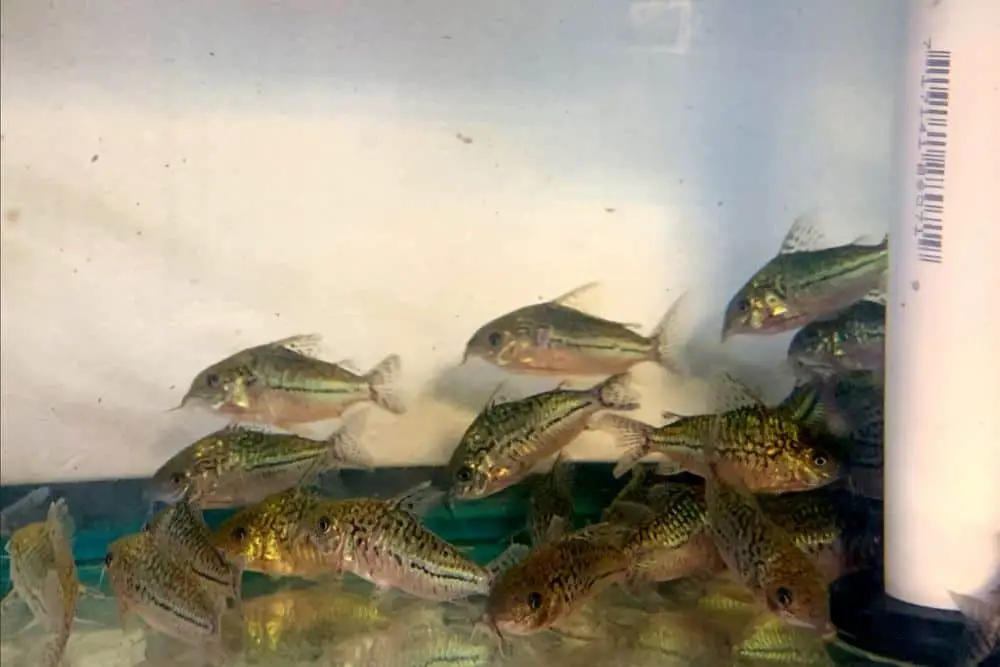
With a silver body and a black pattern, this is a fish that stands out well in an aquarium. The base color of the body is a very bright, silvery-white, with four black lines broken up into unevenly edged, small blotches. There is a large, jet-black blotch in the base of the dorsal fin that runs into the body. The fins are clear, and the tail has a fine pattern of black vertical lines in it.
Agassizi Cory is a very hardy fish that can be introduced into a relatively new aquarium after about four weeks. A small shoal of these fish is preferable, as they like to swim across the substrate, grazing for food together. Breeding is quite easily achieved, given the right conditions.
As with other corydoras, they will eat just about all live, frozen, and flake food. They swim in the lower half of the aquarium and are not one of the first to feed, so ensure that there is enough for them to eat without overfeeding.
Albino Aeneus Cory Cat(Corydoras aeneus)
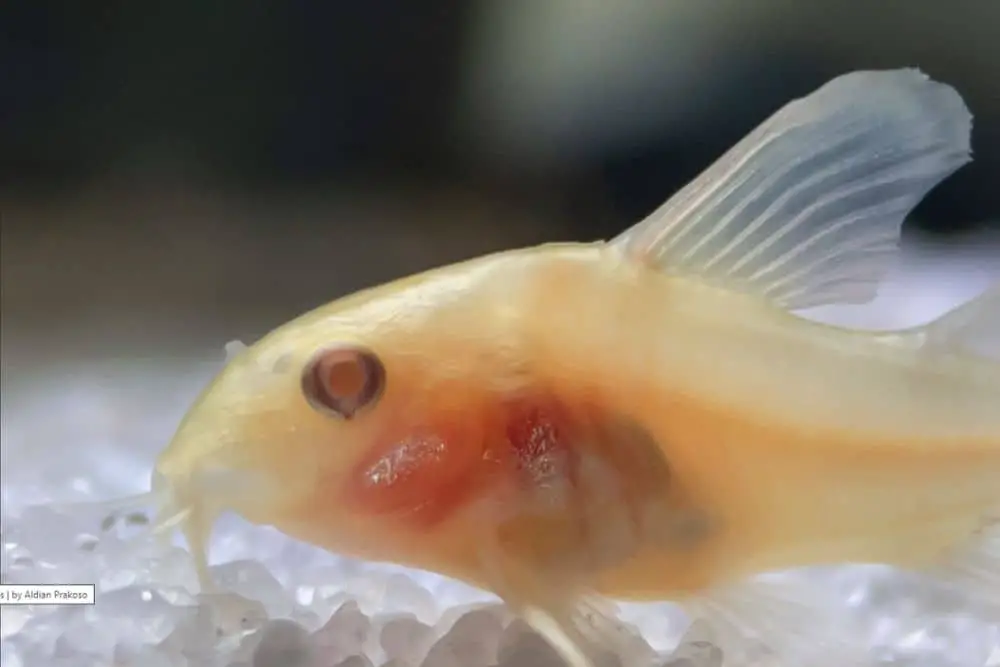
This is one of the three most common corydoras available, partly because
it is so easy to breed. The albino corydoras is one of the numbers of fish that
are completely supplied by commercial breeders (none are captured from the wild).
They are an extremely hardy fish and can be placed in a two-week-old aquarium. This fish is an albino form of the bronze corydoras. Not only is the eye reddish-pink, but the body is pink all over. Sexing is quite easy: when looking from above, the female appears much more barrel-shaped than the male. Use only rounded gravel, such as Dorset pea, which will not ruin their long barrels. As with all corydoras, a sand substrate would be better.
Arched Corydoras (Corydoras arcuatus)
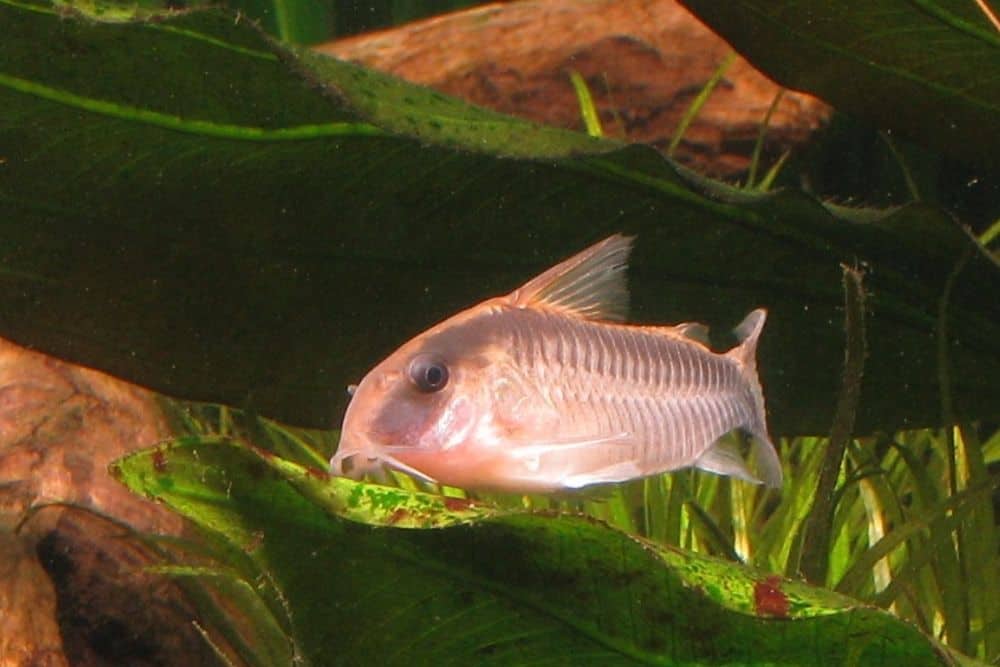
The arched corydoras is a very attractive and hardy fish. It has a stocky body, with a creamy-white base body color and a thick, black bar running
through the eye, following the crown of the back, right through to the lower lobe of the tail.
This black bar will practically disappear when the fish is stressed or frightened. Once settled, it will reappear quite quickly. The snout is extremely rounded, with prominent barbels. Sexing is reasonably easy, but breeding can be a challenge. Once conditions are right, the fry are quite easy to raise.
Bronze Corydoras (Corydoras aeneus)
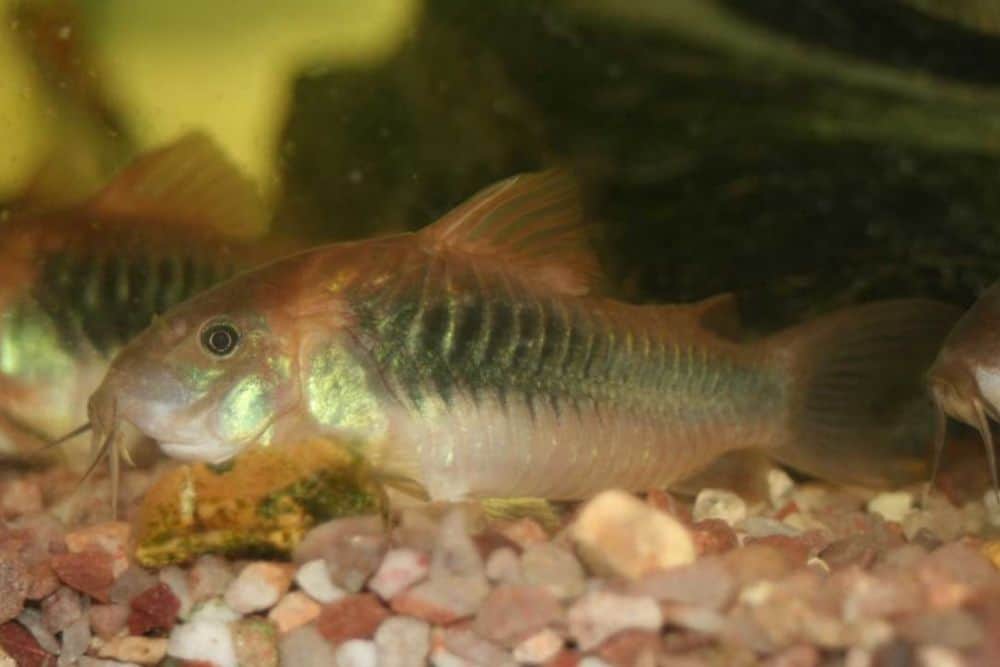
This is one of the three most common corydoras available, partly because
it is so easy to breed. Almost all bronze corydoras are supplied by commercial breeders in the Far East and are not collected from wild habitats. They are extremely hardy, although they can be shy and hide in plants.
As their name suggests, they are bronze brown, normally with two very dark, large patches in the body. This is an ideal fish to add to a two-week-old aquarium. Use only rounded gravel, such as Dorset pea, because this will not ruin their long barrels. As with all corydoras, a sand substrate would be better.
Elegant Corydoras (Corydoras elegans)
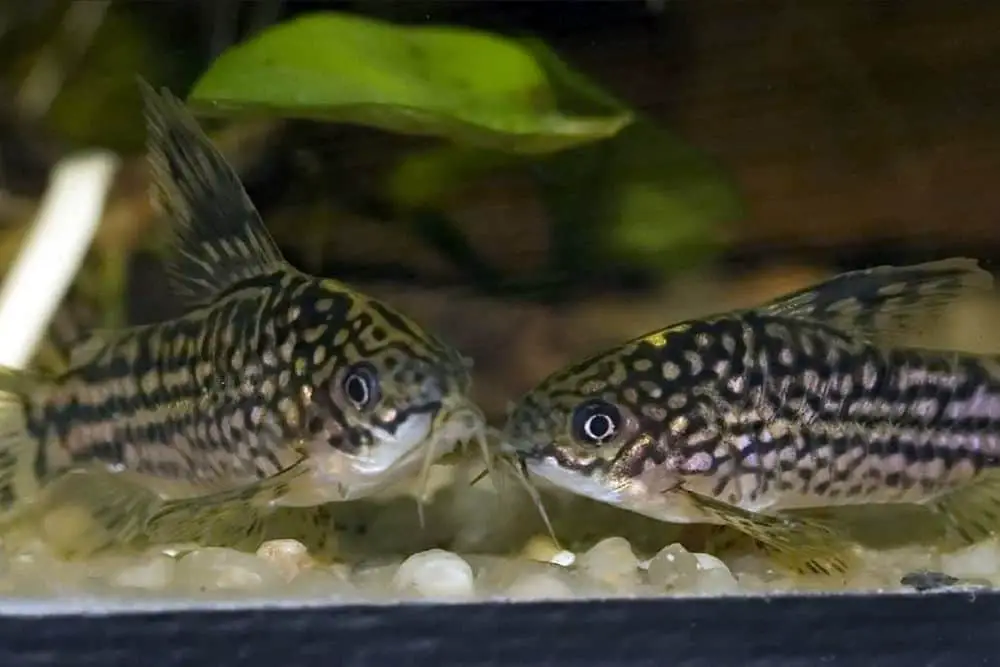
These are fish that have been known and kept by aquarists for many years. They do not grow as large as many other corydoras and so suit slightly smaller aquariums. They are widely available and are reasonably cheap. They are very easy to keep and maintain.
Sexing is easy: the male is quite slim, and from above the female is more rotund. Breeding and raising are simple, as there is no parental care from the adults. It is best to spawn them in a separate aquarium, where the fry can be raised.
pygmy Corydoras (Corydoras pygmaeus)
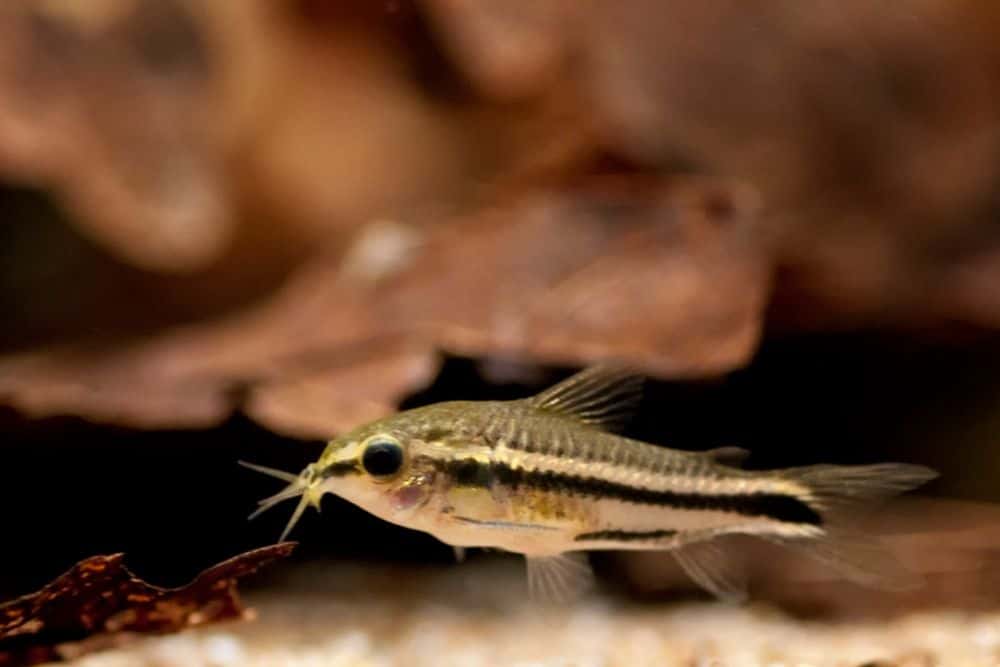
Corydoras habrosus is one of a small group of true pygmy corydoras. When first imported, they are no more than about 0.5 to 0.75in. in length. In the wild, they shoal in great numbers, so the more you can place in your aquarium, the happier they will be.
They tend to swim and hover together just off the bottom of the aquarium rather than grazing the substrate looking for food like most other corydoras. They are a very attractive little fish, with a barrel-like body and pretty markings. They are very easy to sex, as the female is much thicker in the body than the male, but they are quite difficult to breed.
Leopard Cory (Corydoras trilineatus)
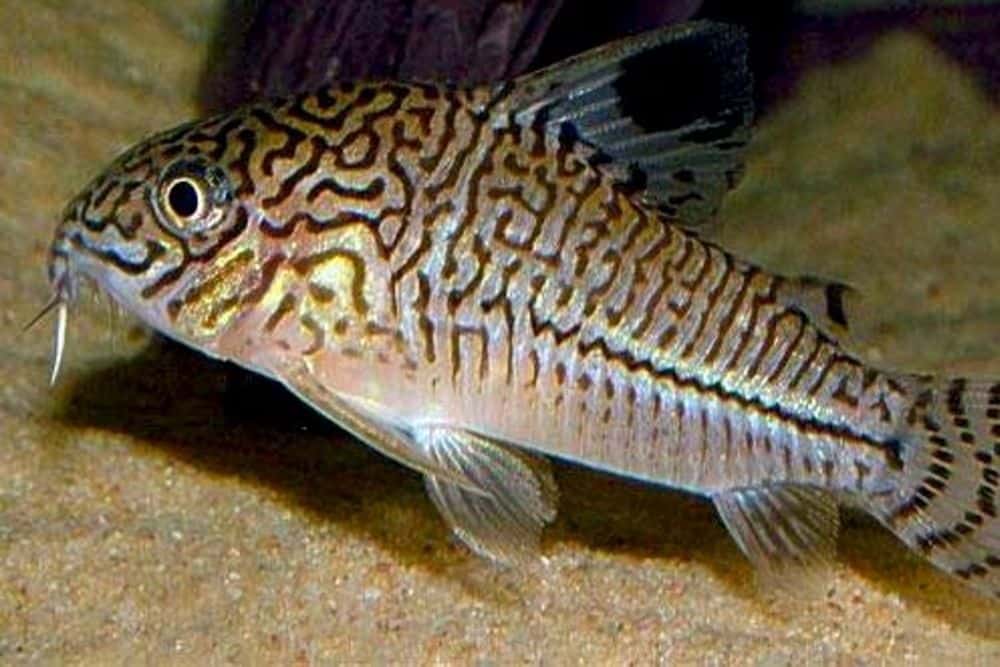
The body of the leopard corydoras is covered in tiny black spots, with a line of slightly larger spots running down the lateral line of the fish over a base color of silvery-white, hence the name of the fish. The dorsal has a large black blotch in the upper part, and the tail has a fine pattern all over it. It is a very pretty fish.
The snout is extremely rounded and blunt. Corydorasjullii is one of the most common corydoras available. When breeding, this fish will quite happily cross with Corydoras trilineatus, which will achieve a slight variation in patterning. They are very easy to keep and maintain and like well-oxygenated and well-filtered aquarium water.
False Bandit Cory (Corydoras melini)
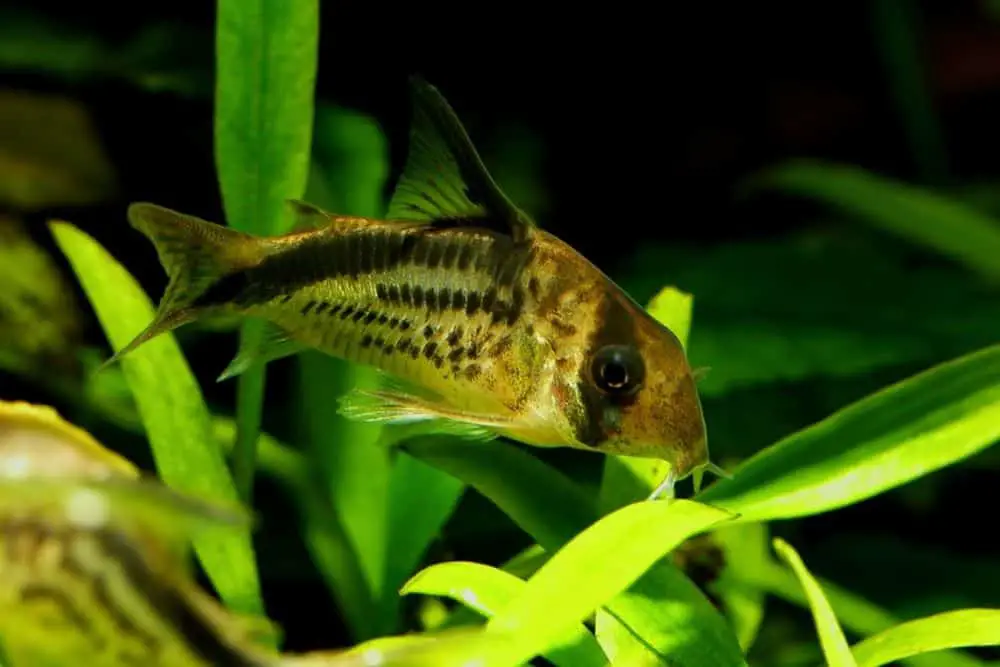
This is a recent addition to aquaria, but is now well established. Not as freely available as some, it is slightly more expensive than many other corydoras. It is a very good-looking, solid fish with a creamy base body color and a black bar running from within the dorsal fin, down the crown of the back into the lower lobe of the tail.
There is also a wide black bar running vertically through the eye, which is known as a mask, hence its name. It is quite a hardy fish that will accept small changes in pH levels but does need high oxygenation levels and a well-maintained filtration system. It will not tolerate any nitrite problems.
Peppered Corydoras (Corydoras paleatus)
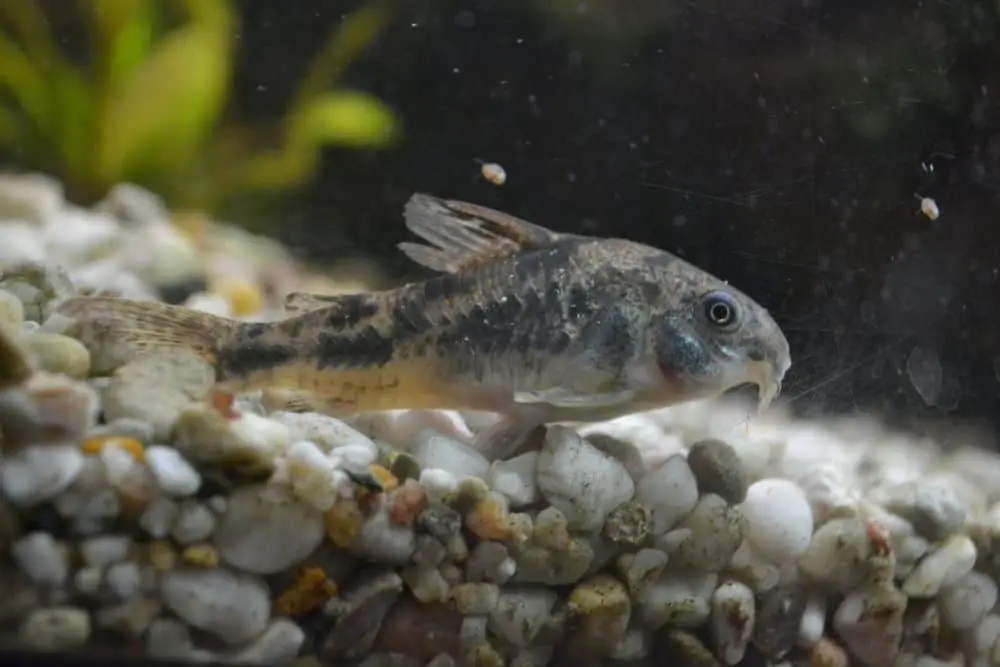
This fish is one of the three most popular corydoras available. Commercial breeders supply most of them because they are so easy to breed. They are extremely peaceful, hardy, and long-lived, and have a wonderful habit of sitting on the substrate looking through the aquarium’s front glass and “winking’’ at whoever is watching them.
The body color is olive green, with mottled dark-green, almost black, markings. No two fish have exactly the same patterns. The tail has faint spots and the other fins are usually clear of any color. The male has a much larger, pointed dorsal fin than the female, although body shape is a clearer aid to identification.
Spotted or Dotted Corydoras (Corydoras melanistius)
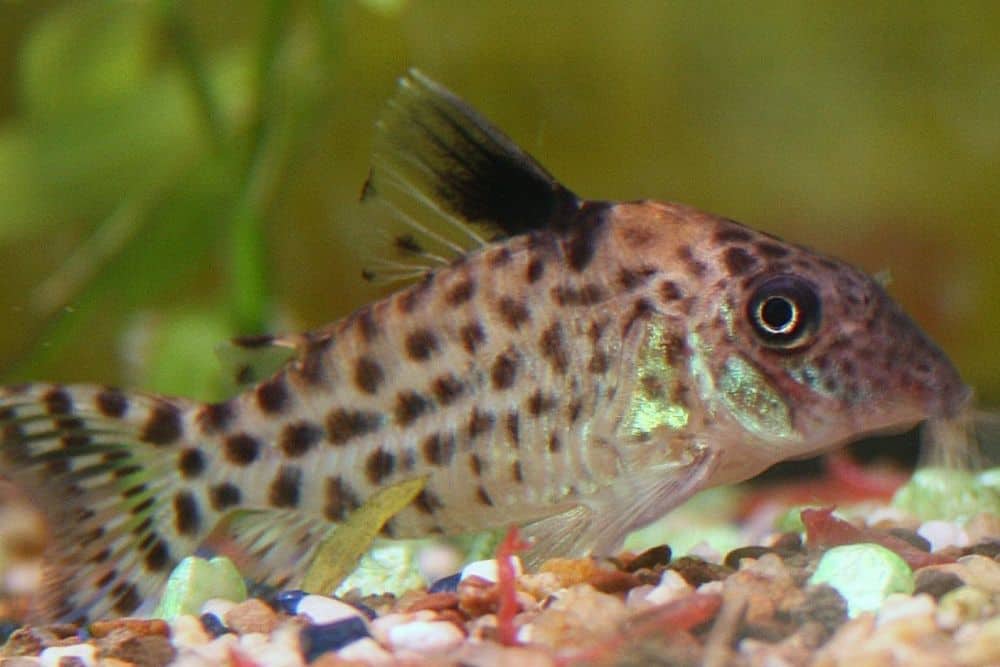
You can buy so many pattern variations of this fish that it is very difficult
to give a concise and accurate description. Generally, the dorsal fin has a large, black spot, the body has spots all over it (ranging from tiny dots to
large spots), the tail has fine, spotted markings, the other fins are clear, and the snout is rounded. Basically, they all have a black-and-white pattern and the variations are very pretty.
As with all other corydoras, they are community fish, seemingly always grubbing around the bottom of the tank, looking for food. They are one of the easier corydoras to breed. They lay adhesive eggs, normally on the glass wall of the aquarium, which sticks there until they hatch and then drop to the bottom of the aquarium. There is no parental care from the adults.
Flagtail Corydoras (Corydoras Robbinae)
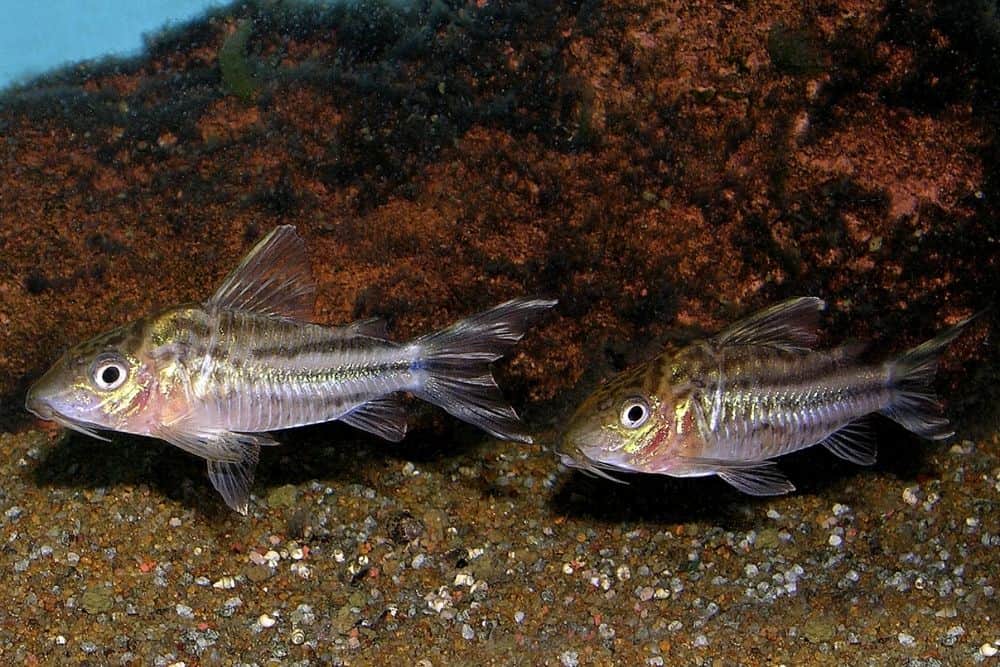
This is an active, eye-catching fish, constantly on the move and with striking black-and-white markings on the tail. It is not a shy fish that retires among the plants but is nearly always at the front of the aquarium and on show. There is very little information about breeding. The male and female are identical in markings, but the female, as with most other corydoras, is plumper in the body.
Schwartz’s Corydoras (Corydoras Schwartzi)
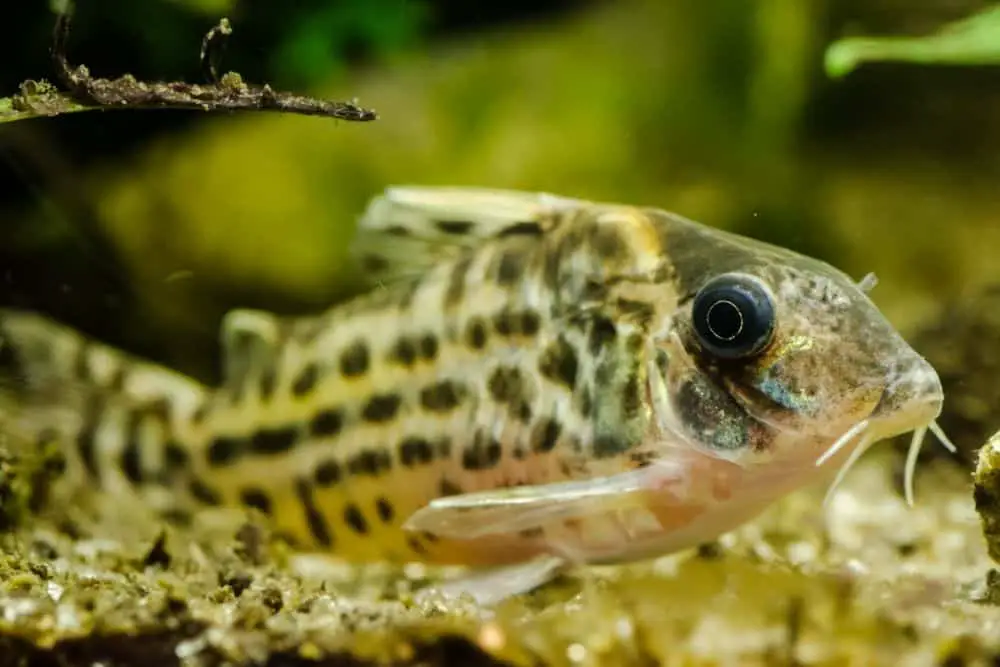
There are so many pattern variations of this fish that it is very difficult to
give an accurate description. Generally, there is a large, black bar running
up the front of the dorsal fin. The body has lines of broken spots along with it, ranging from tiny dots to large spots, the tail has fine, spotted markings,
the other fins are clear, and the snout is rounded.
The barbels are white and quite pronounced. Basically, they all have a black-and-white pattern. All of the variations are very pretty. As with all other corydoras, they are good community fish, often grubbing around the bottom of the tank, looking for food. They are one of the easier corydoras to breed. They lay adhesive eggs, normally on the glass wall of the aquarium, where they stick until they hatch, when they drop to the bottom of the aquarium. There is no parental care from the adults.
Corydoras Sterbai (Sterba’s Cory)
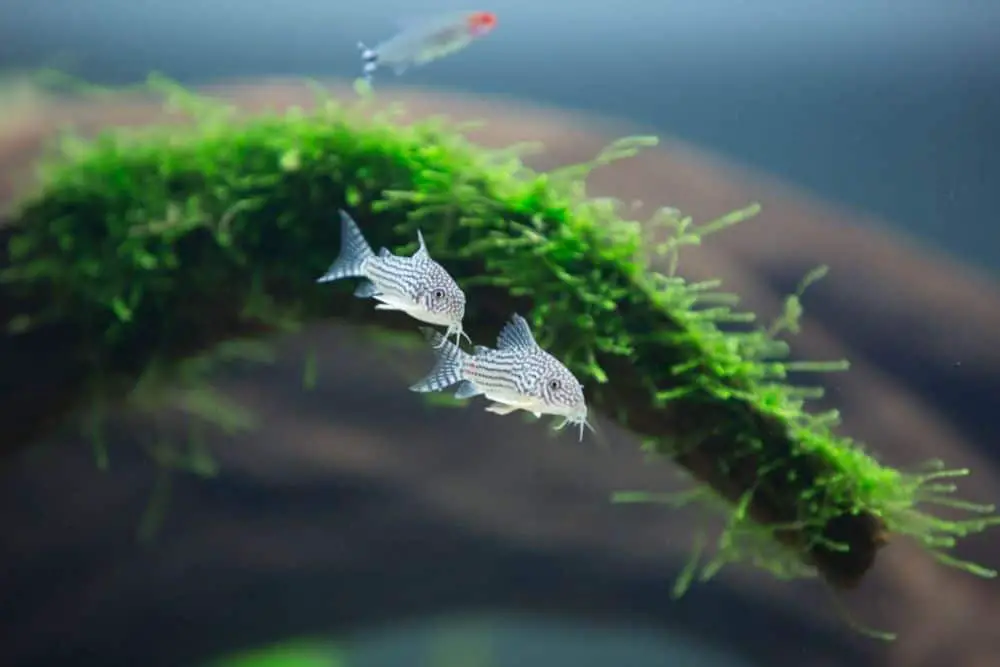
This fish is another relative newcomer to the hobby and a very beautiful one at that. Corydoras sterbai is a very stocky fish, being quite wide in the body, as well as deep, with striking patterning. It has very strong lines down the length of the body, made up of a series of large dots, with patterns on the fins, too.
They have long barbels so that they can dig around in the substrate for food. The snout is very blunt and rounded. This fish is very similar to Corydoras baroldschultzi and is easily confused with it Little is known about breeding this fish, but it is presumed to be the same as other corydoras.

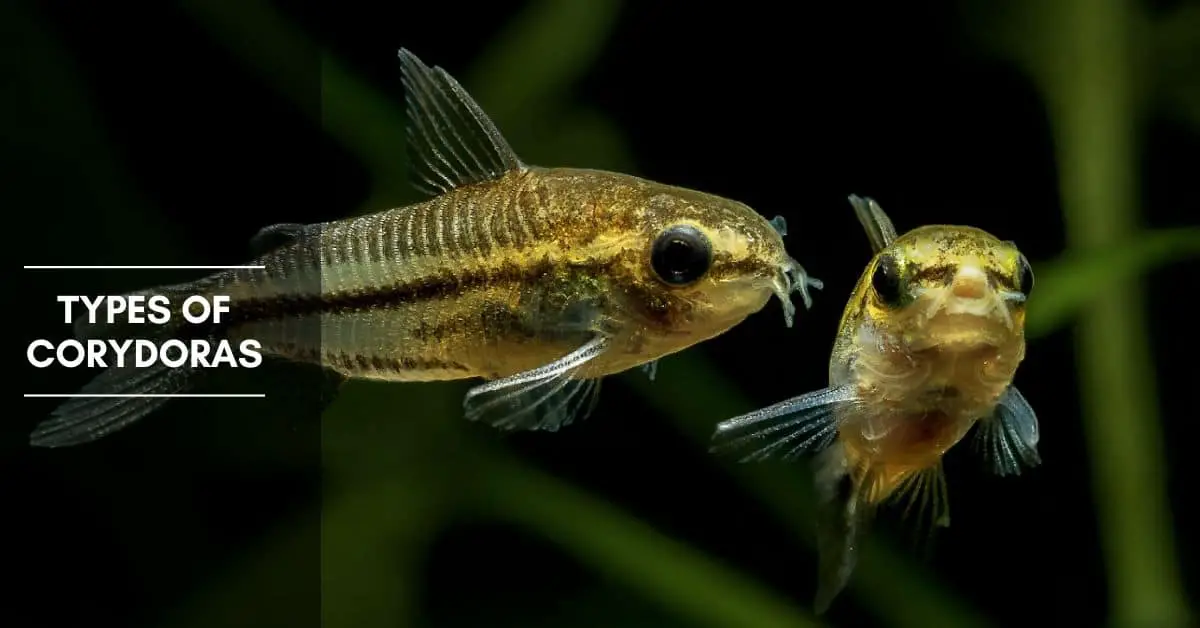








![UNS Ultra Clear Rimless Tank - 3.4GAL | 13L - 17.71x6.69x6.69 | 45x17x17 CM, 5mm Glass Thickness, Leveling Mat Included - Low Iron, High Clarity Fish Tank w/ 45° Mitered Edge - [45L] #1](https://m.media-amazon.com/images/I/411rag-0N-L._SL100_.jpg)
![UNS Ultra Clear Rimless Tank - 3.4GAL | 13L - 17.71x6.69x6.69 | 45x17x17 CM, 5mm Glass Thickness, Leveling Mat Included - Low Iron, High Clarity Fish Tank w/ 45° Mitered Edge - [45L] #2](https://m.media-amazon.com/images/I/41d23jD8FfL._SL100_.jpg)
![UNS Ultra Clear Rimless Tank - 3.4GAL | 13L - 17.71x6.69x6.69 | 45x17x17 CM, 5mm Glass Thickness, Leveling Mat Included - Low Iron, High Clarity Fish Tank w/ 45° Mitered Edge - [45L] #3](https://m.media-amazon.com/images/I/41WpCkdLITL._SL100_.jpg)
![UNS Ultra Clear Rimless Tank - 3.4GAL | 13L - 17.71x6.69x6.69 | 45x17x17 CM, 5mm Glass Thickness, Leveling Mat Included - Low Iron, High Clarity Fish Tank w/ 45° Mitered Edge - [45L] #4](https://m.media-amazon.com/images/I/41lmvv2awTL._SL100_.jpg)
![UNS Ultra Clear Rimless Tank - 3.4GAL | 13L - 17.71x6.69x6.69 | 45x17x17 CM, 5mm Glass Thickness, Leveling Mat Included - Low Iron, High Clarity Fish Tank w/ 45° Mitered Edge - [45L] #5](https://m.media-amazon.com/images/I/41XsXgcYThL._SL100_.jpg)



